run flat VOLKSWAGEN TIGUAN 2017 Owner´s Manual
[x] Cancel search | Manufacturer: VOLKSWAGEN, Model Year: 2017, Model line: TIGUAN, Model: VOLKSWAGEN TIGUAN 2017Pages: 341, PDF Size: 9.14 MB
Page 139 of 341
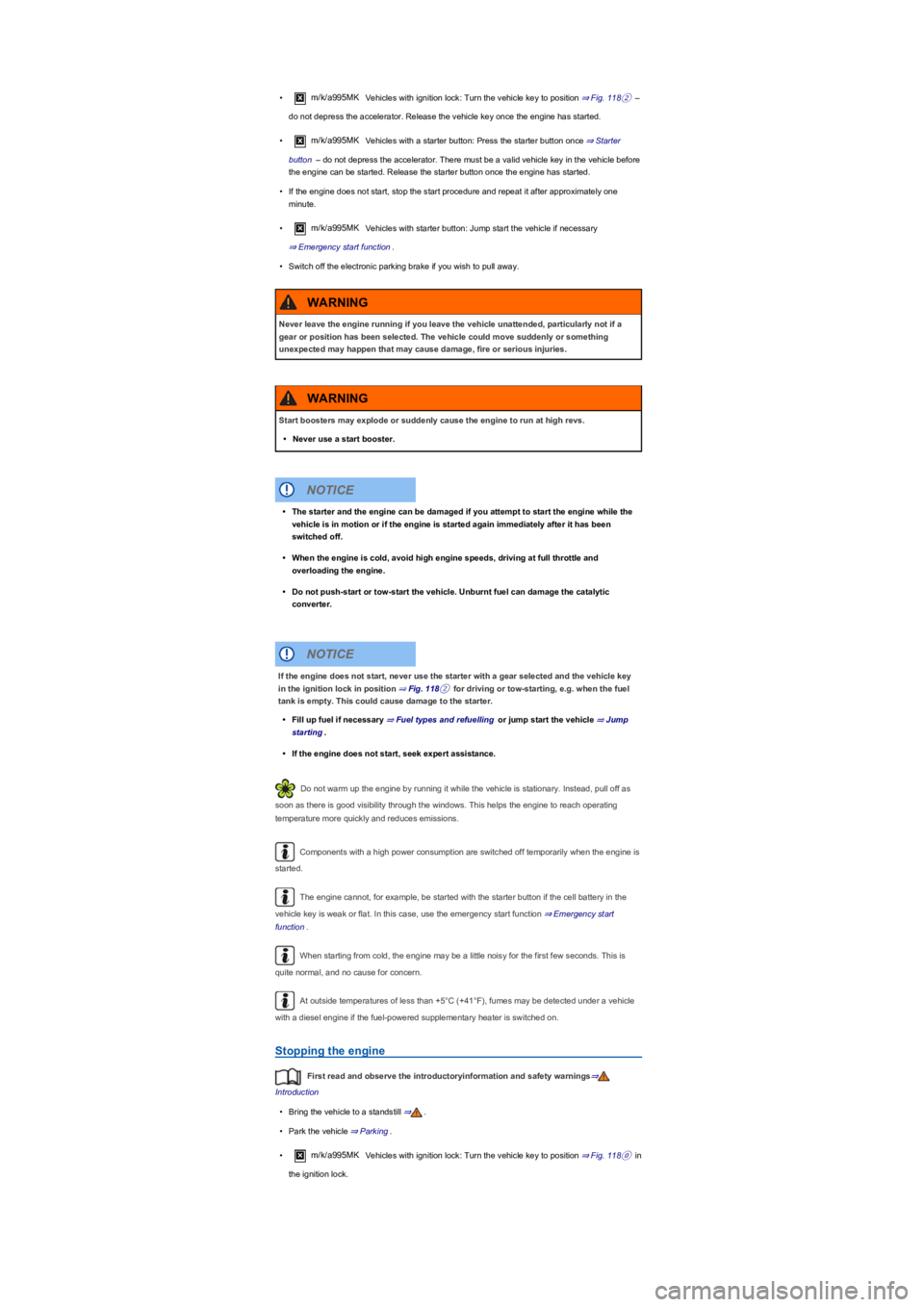
•m/k/a995MKVehicles with ignition lock: Turn the vehicle key to position ⇒ Fig. 118② –
do not depress the accelerator. Release the vehicle key once the engine has started.
•m/k/a995MKVehicles with a starter button: Press the starter button once ⇒ Starter
button – do not depress the accelerator. There must be a valid vehicle key in the vehicle before
the engine can be started. Release the starter button once the engine has started.
•If the engine does not start, stop the start procedure and repeat it after approximately one
minute.
•m/k/a995MK Vehicles with starter button: Jump start the vehicle if necessary
⇒ Emergency start function.
•Switch off the electronic parking brake if you wish to pull away.
Do not warm up the engine by running it while the vehicle is stationary. Instead, pull off as
soon as there is good visibility through the windows. This helps the engine to reach operating
temperature more quickly and reduces emissions.
Components with a high power consumption are switched off temporarily when the engine is
started.
The engine cannot, for example, be started with the starter button if the cell battery in the
vehicle key is weak or flat. In this case, use the emergency start function ⇒ Emergency start
function.
When starting from cold, the engine may be a little noisy for the first few seconds. This is
quite normal, and no cause for concern.
At outside temperatures of less than +5°C (+41°F), fumes may be detected under a vehicle
with a diesel engine if the fuel-powered supplementary heater is switched on.
Stopping the engine
First read and observe the introductoryinformation and safety warnings⇒
Introduction
•Bring the vehicle to a standstill ⇒.
•Park the vehicle ⇒ Parking.
•m/k/a995MKVehicles with ignition lock: Turn the vehicle key to position ⇒ Fig. 118⓪ in
the ignition lock.
Never leave the engine running if you leave the vehicle unattended, particularly not if a
gear or position has been selected. The vehicle could move suddenly or something
unexpected may happen that may cause damage, fire or serious injuries.
WARNING
Start boosters may explode or suddenly cause the engine to run at high revs.
•Never use a start booster.
WARNING
•The starter and the engine can be damaged if you attempt to start the engine while the
vehicle is in motion or if the engine is started again immediately after it has been
switched off.
•When the engine is cold, avoid high engine speeds, driving at full throttle and
overloading the engine.
•Do not push-start or tow-start the vehicle. Unburnt fuel can damage the catalytic
converter.
NOTICE
If the engine does not start, never use the starter with a gear selected and the vehicle key
in the ignition lock in position ⇒ Fig. 118② for driving or tow-starting, e.g. when the fuel
tank is empty. This could cause damage to the starter.
•Fill up fuel if necessary ⇒ Fuel types and refuelling or jump start the vehicle ⇒ Jump
starting.
•If the engine does not start, seek expert assistance.
NOTICE
Page 190 of 341
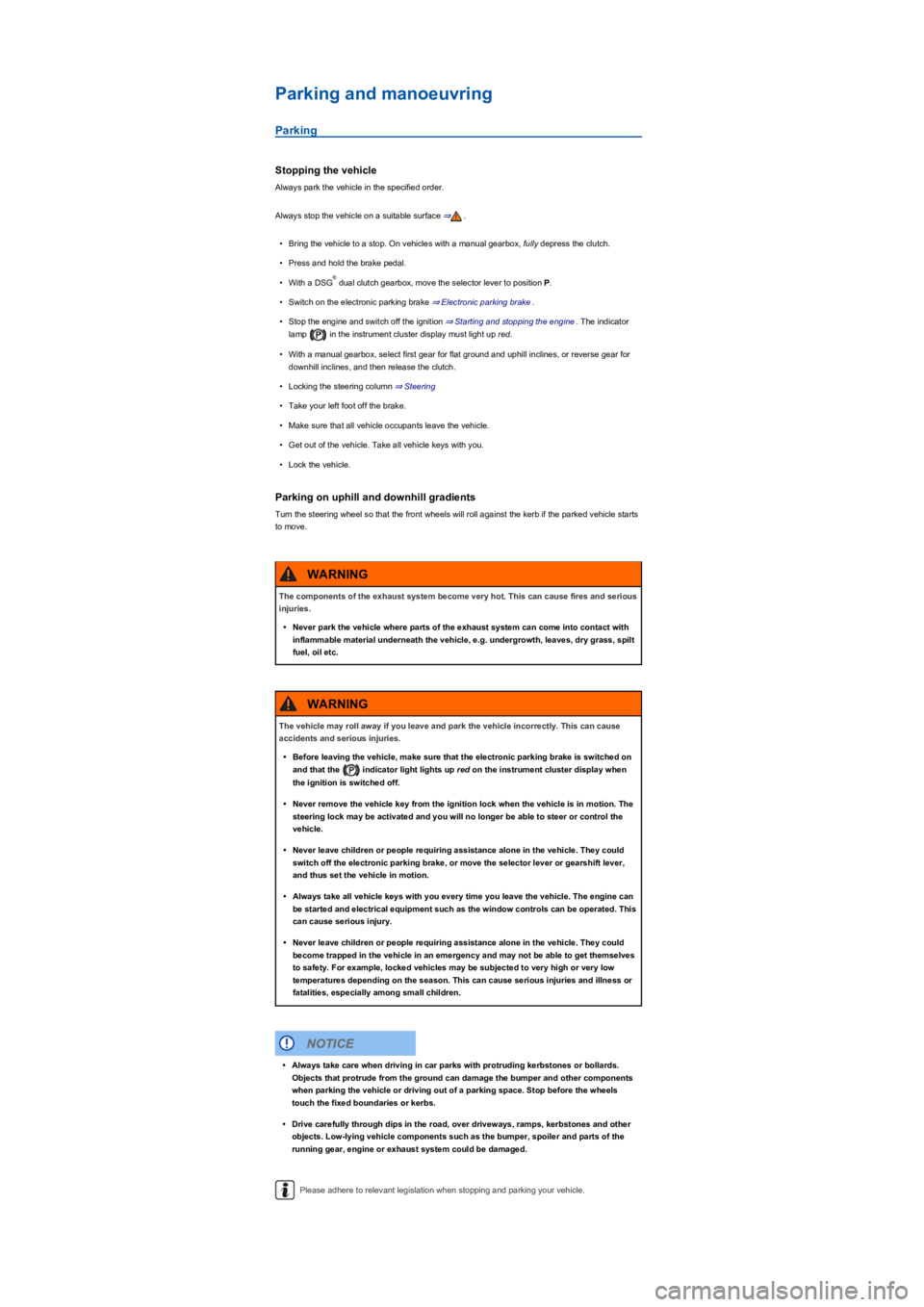
Parking and manoeuvring
Parking
Stopping the vehicle
Always park the vehicle in the specified order.
Always stop the vehicle on a suitable surface ⇒.
•Bring the vehicle to a stop. On vehicles with a manual gearbox, fully depress the clutch.
•Press and hold the brake pedal.
•With a DSG dual clutch gearbox, move the selector lever to position P.
•Switch on the electronic parking brake ⇒ Electronic parking brake.
•Stop the engine and switch off the ignition ⇒ Starting and stopping the engine. The indicator
lamp in the instrument cluster display must light up red.
•With a manual gearbox, select first gear for flat ground and uphill inclines, or reverse gear for
downhill inclines, and then release the clutch.
•Locking the steering column ⇒ Steering
•Take your left foot off the brake.
•Make sure that all vehicle occupants leave the vehicle.
•Get out of the vehicle. Take all vehicle keys with you.
•Lock the vehicle.
Parking on uphill and downhill gradients
Turn the steering wheel so that the front wheels will roll against the kerb if the parked vehicle starts
to move.
Please adhere to relevant legislation when stopping and parking your vehicle.
®
The components of the exhaust system become very hot. This can cause fires and serious
injuries.
•Never park the vehicle where parts of the exhaust system can come into contact with
inflammable material underneath the vehicle, e.g. undergrowth, leaves, dry grass, spilt
fuel, oil etc.
WARNING
The vehicle may roll away if you leave and park the vehicle incorrectly. This can cause
accidents and serious injuries.
•Before leaving the vehicle, make sure that the electronic parking brake is switched on
and that the indicator light lights up red on the instrument cluster display when
the ignition is switched off.
•Never remove the vehicle key from the ignition lock when the vehicle is in motion. The
steering lock may be activated and you will no longer be able to steer or control the
vehicle.
•Never leave children or people requiring assistance alone in the vehicle. They could
switch off the electronic parking brake, or move the selector lever or gearshift lever,
and thus set the vehicle in motion.
•Always take all vehicle keys with you every time you leave the vehicle. The engine can
be started and electrical equipment such as the window controls can be operated. This
can cause serious injury.
•Never leave children or people requiring assistance alone in the vehicle. They could
become trapped in the vehicle in an emergency and may not be able to get themselves
to safety. For example, locked vehicles may be subjected to very high or very low
temperatures depending on the season. This can cause serious injuries and illness or
fatalities, especially among small children.
WARNING
•Always take care when driving in car parks with protruding kerbstones or bollards.
Objects that protrude from the ground can damage the bumper and other components
when parking the vehicle or driving out of a parking space. Stop before the wheels
touch the fixed boundaries or kerbs.
•Drive carefully through dips in the road, over driveways, ramps, kerbstones and other
objects. Low-lying vehicle components such as the bumper, spoiler and parts of the
running gear, engine or exhaust system could be damaged.
NOTICE
Page 224 of 341
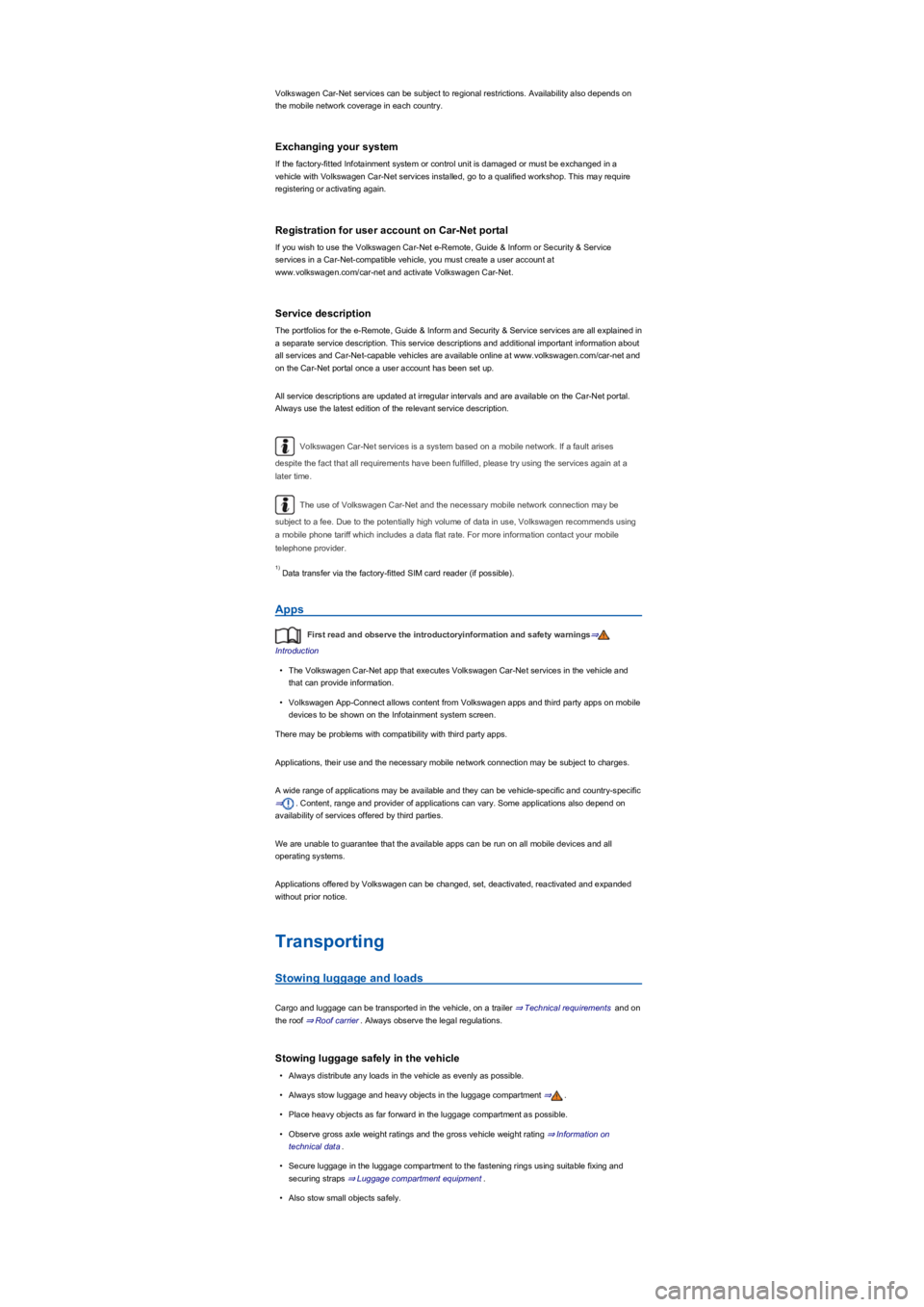
Volkswagen Car-Net services can be subject to regional restrictions. Availability also depends on
the mobile network coverage in each country.
Exchanging your system
If the factory-fitted Infotainment system or control unit is damaged or must be exchanged in a
vehicle with Volkswagen Car-Net services installed, go to a qualified workshop. This may require
registering or activating again.
Registration for user account on Car-Net portal
If you wish to use the Volkswagen Car-Net e-Remote, Guide & Inform or Security & Service
services in a Car-Net-compatible vehicle, you must create a user account at
www.volkswagen.com/car-net and activate Volkswagen Car-Net.
Service description
The portfolios for the e-Remote, Guide & Inform and Security & Service services are all explained in
a separate service description. This service descriptions and additional important information about
all services and Car-Net-capable vehicles are available online at www.volkswagen.com/car-net and
on the Car-Net portal once a user account has been set up.
All service descriptions are updated at irregular intervals and are available on the Car-Net portal.
Always use the latest edition of the relevant service description.
Volkswagen Car-Net services is a system based on a mobile network. If a fault arises
despite the fact that all requirements have been fulfilled, please try using the services again at a
later time.
The use of Volkswagen Car-Net and the necessary mobile network connection may be
subject to a fee. Due to the potentially high volume of data in use, Volkswagen recommends using
a mobile phone tariff which includes a data flat rate. For more information contact your mobile
telephone provider.
Data transfer via the factory-fitted SIM card reader (if possible).
Apps
First read and observe the introductoryinformation and safety warnings⇒
Introduction
•The Volkswagen Car-Net app that executes Volkswagen Car-Net services in the vehicle and
that can provide information.
•Volkswagen App-Connect allows content from Volkswagen apps and third party apps on mobile
devices to be shown on the Infotainment system screen.
There may be problems with compatibility with third party apps.
Applications, their use and the necessary mobile network connection may be subject to charges.
A wide range of applications may be available and they can be vehicle-specific and country-specific
⇒. Content, range and provider of applications can vary. Some applications also depend on
availability of services offered by third parties.
We are unable to guarantee that the available apps can be run on all mobile devices and all
operating systems.
Applications offered by Volkswagen can be changed, set, deactivated, reactivated and expanded
without prior notice.
Transporting
Stowing luggage and loads
Cargo and luggage can be transported in the vehicle, on a trailer ⇒ Technical requirements and on
the roof ⇒ Roof carrier. Always observe the legal regulations.
Stowing luggage safely in the vehicle
•Always distribute any loads in the vehicle as evenly as possible.
•Always stow luggage and heavy objects in the luggage compartment ⇒.
•Place heavy objects as far forward in the luggage compartment as possible.
•Observe gross axle weight ratings and the gross vehicle weight rating ⇒ Information on
technical data.
•Secure luggage in the luggage compartment to the fastening rings using suitable fixing and
securing straps ⇒ Luggage compartment equipment.
•Also stow small objects safely.
1)
Page 239 of 341
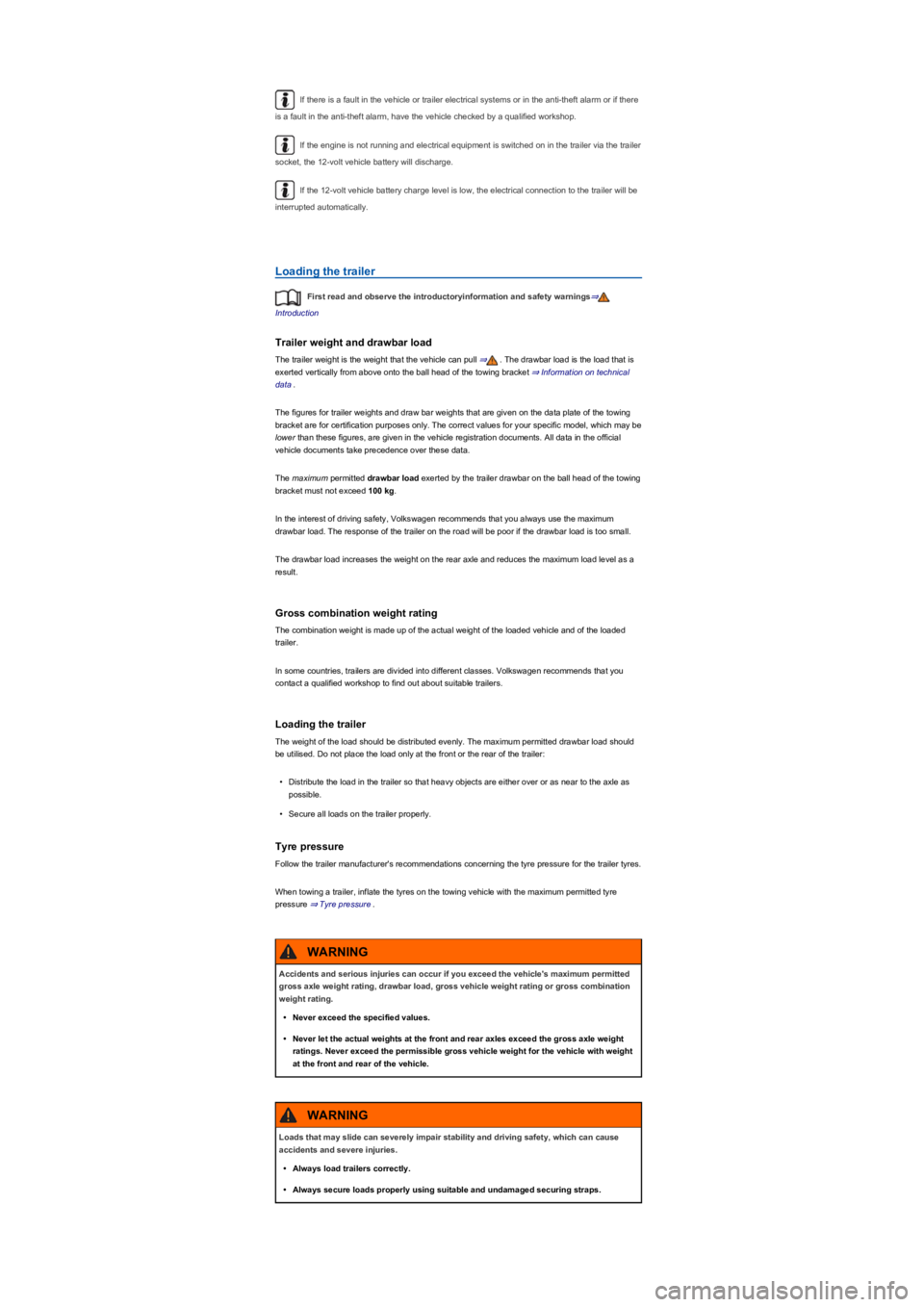
If there is a fault in the vehicle or trailer electrical systems or in the anti-theft alarm or if there
is a fault in the anti-theft alarm, have the vehicle checked by a qualified workshop.
If the engine is not running and electrical equipment is switched on in the trailer via the trailer
socket, the 12-volt vehicle battery will discharge.
If the 12-volt vehicle battery charge level is low, the electrical connection to the trailer will be
interrupted automatically.
Loading the trailer
First read and observe the introductoryinformation and safety warnings⇒
Introduction
Trailer weight and drawbar load
The trailer weight is the weight that the vehicle can pull ⇒. The drawbar load is the load that is
exerted vertically from above onto the ball head of the towing bracket ⇒ Information on technical
data.
The figures for trailer weights and draw bar weights that are given on the data plate of the towing
bracket are for certification purposes only. The correct values for your specific model, which may be
lower than these figures, are given in the vehicle registration documents. All data in the official
vehicle documents take precedence over these data.
The maximum permitted drawbar load exerted by the trailer drawbar on the ball head of the towing
bracket must not exceed 100 kg.
In the interest of driving safety, Volkswagen recommends that you always use the maximum
drawbar load. The response of the trailer on the road will be poor if the drawbar load is too small.
The drawbar load increases the weight on the rear axle and reduces the maximum load level as a
result.
Gross combination weight rating
The combination weight is made up of the actual weight of the loaded vehicle and of the loaded
trailer.
In some countries, trailers are divided into different classes. Volkswagen recommends that you
contact a qualified workshop to find out about suitable trailers.
Loading the trailer
The weight of the load should be distributed evenly. The maximum permitted drawbar load should
be utilised. Do not place the load only at the front or the rear of the trailer:
•Distribute the load in the trailer so that heavy objects are either over or as near to the axle as
possible.
•Secure all loads on the trailer properly.
Tyre pressure
Follow the trailer manufacturer's recommendations concerning the tyre pressure for the trailer tyres.
When towing a trailer, inflate the tyres on the towing vehicle with the maximum permitted tyre
pressure ⇒ Tyre pressure.
Accidents and serious injuries can occur if you exceed the vehicle's maximum permitted
gross axle weight rating, drawbar load, gross vehicle weight rating or gross combination
weight rating.
•Never exceed the specified values.
•Never let the actual weights at the front and rear axles exceed the gross axle weight
ratings. Never exceed the permissible gross vehicle weight for the vehicle with weight
at the front and rear of the vehicle.
WARNING
Loads that may slide can severely impair stability and driving safety, which can cause
accidents and severe injuries.
•Always load trailers correctly.
•Always secure loads properly using suitable and undamaged securing straps.
WARNING
Page 266 of 341
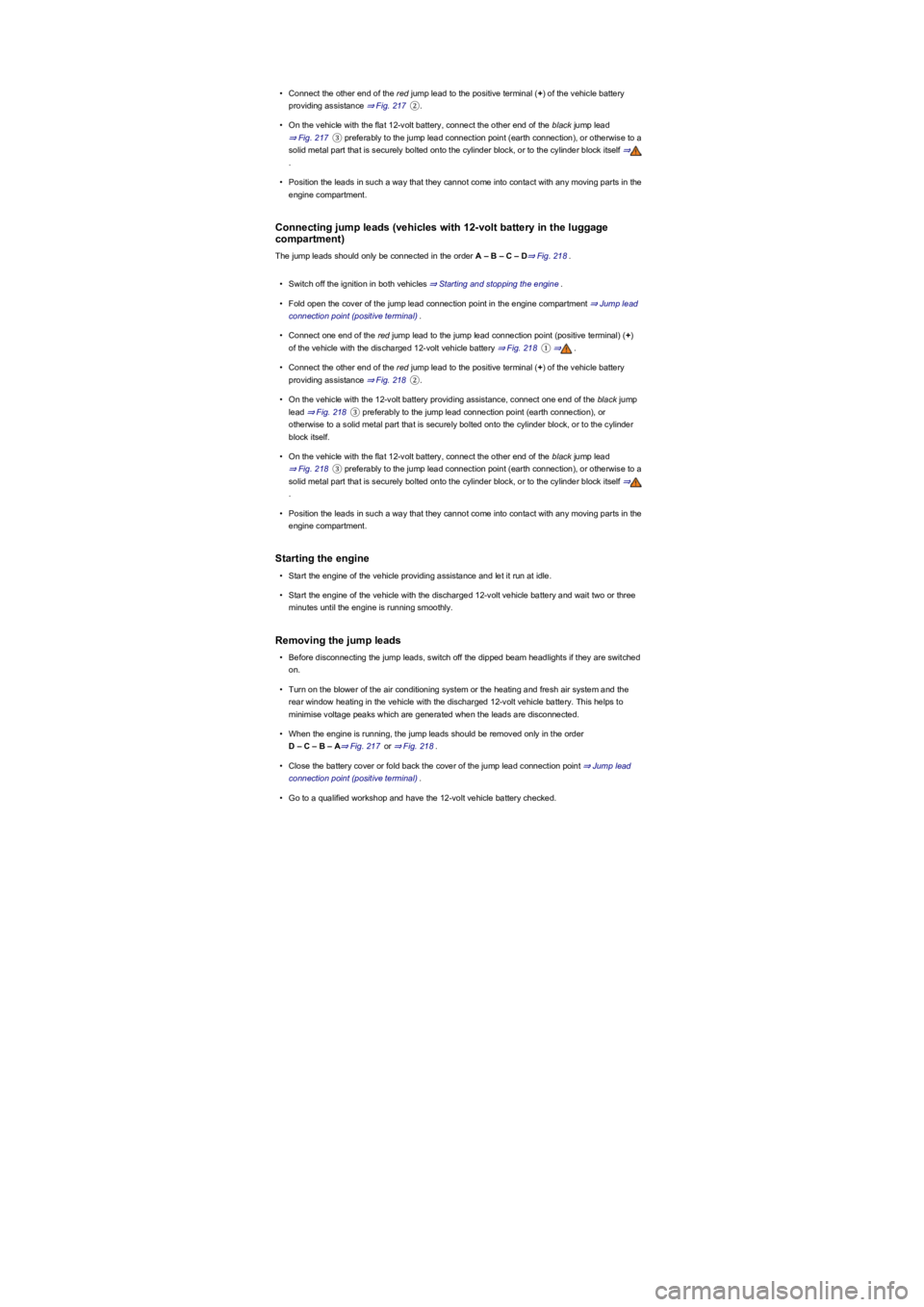
•Connect the other end of the red jump lead to the positive terminal (+) of the vehicle battery
providing assistance ⇒ Fig. 217②.
•On the vehicle with the flat 12-volt battery, connect the other end of the black jump lead
⇒ Fig. 217③ preferably to the jump lead connection point (earth connection), or otherwise to a
solid metal part that is securely bolted onto the cylinder block, or to the cylinder block itself ⇒
.
•Position the leads in such a way that they cannot come into contact with any moving parts in the
engine compartment.
Connecting jump leads (vehicles with 12-volt battery in the luggage
compartment)
The jump leads should only be connected in the order A – B – C – D⇒ Fig. 218.
•Switch off the ignition in both vehicles ⇒ Starting and stopping the engine.
•Fold open the cover of the jump lead connection point in the engine compartment ⇒ Jump lead
connection point (positive terminal).
•Connect one end of the red jump lead to the jump lead connection point (positive terminal) (+)
of the vehicle with the discharged 12-volt vehicle battery ⇒ Fig. 218①⇒.
•Connect the other end of the red jump lead to the positive terminal (+) of the vehicle battery
providing assistance ⇒ Fig. 218②.
•On the vehicle with the 12-volt battery providing assistance, connect one end of the black jump
lead ⇒ Fig. 218③ preferably to the jump lead connection point (earth connection), or
otherwise to a solid metal part that is securely bolted onto the cylinder block, or to the cylinder
block itself.
•On the vehicle with the flat 12-volt battery, connect the other end of the black jump lead
⇒ Fig. 218③ preferably to the jump lead connection point (earth connection), or otherwise to a
solid metal part that is securely bolted onto the cylinder block, or to the cylinder block itself ⇒
.
•Position the leads in such a way that they cannot come into contact with any moving parts in the
engine compartment.
Starting the engine
•Start the engine of the vehicle providing assistance and let it run at idle.
•Start the engine of the vehicle with the discharged 12-volt vehicle battery and wait two or three
minutes until the engine is running smoothly.
Removing the jump leads
•Before disconnecting the jump leads, switch off the dipped beam headlights if they are switched
on.
•Turn on the blower of the air conditioning system or the heating and fresh air system and the
rear window heating in the vehicle with the discharged 12-volt vehicle battery. This helps to
minimise voltage peaks which are generated when the leads are disconnected.
•When the engine is running, the jump leads should be removed only in the order
D – C – B – A⇒ Fig. 217 or ⇒ Fig. 218.
•Close the battery cover or fold back the cover of the jump lead connection point ⇒ Jump lead
connection point (positive terminal).
•Go to a qualified workshop and have the 12-volt vehicle battery checked.
Page 313 of 341
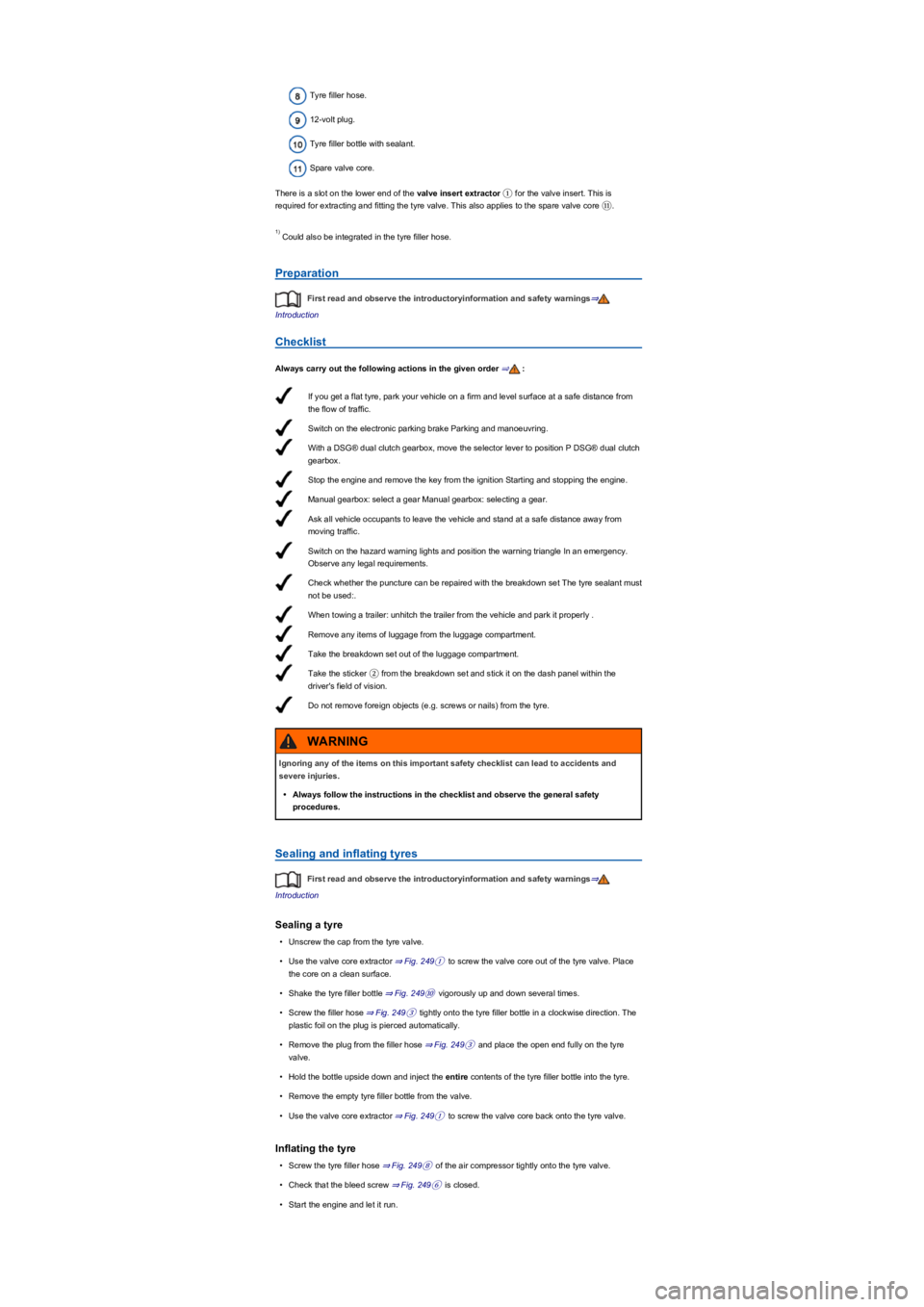
If you get a flat tyre, park your vehicle on a firm and level surface at a safe distance from
the flow of traffic.
Switch on the electronic parking brake Parking and manoeuvring.
With a DSG® dual clutch gearbox, move the selector lever to position P DSG® dual clutch
gearbox.
Stop the engine and remove the key from the ignition Starting and stopping the engine.
Manual gearbox: select a gear Manual gearbox: selecting a gear.
Ask all vehicle occupants to leave the vehicle and stand at a safe distance away from
moving traffic.
Switch on the hazard warning lights and position the warning triangle In an emergency.
Observe any legal requirements.
Check whether the puncture can be repaired with the breakdown set The tyre sealant must
not be used:.
When towing a trailer: unhitch the trailer from the vehicle and park it properly .
Remove any items of luggage from the luggage compartment.
Take the breakdown set out of the luggage compartment.
Take the sticker ② from the breakdown set and stick it on the dash panel within the
driver's field of vision.
Do not remove foreign objects (e.g. screws or nails) from the tyre.
Tyre filler hose.
12-volt plug.
Tyre filler bottle with sealant.
Spare valve core.
There is a slot on the lower end of the valve insert extractor① for the valve insert. This is
required for extracting and fitting the tyre valve. This also applies to the spare valve core ⑪.
Could also be integrated in the tyre filler hose.
Preparation
First read and observe the introductoryinformation and safety warnings⇒
Introduction
Checklist
Always carry out the following actions in the given order ⇒:
Sealing and inflating tyres
First read and observe the introductoryinformation and safety warnings⇒
Introduction
Sealing a tyre
•Unscrew the cap from the tyre valve.
•Use the valve core extractor ⇒ Fig. 249① to screw the valve core out of the tyre valve. Place
the core on a clean surface.
•Shake the tyre filler bottle ⇒ Fig. 249⑩ vigorously up and down several times.
•Screw the filler hose ⇒ Fig. 249③ tightly onto the tyre filler bottle in a clockwise direction. The
plastic foil on the plug is pierced automatically.
•Remove the plug from the filler hose ⇒ Fig. 249③ and place the open end fully on the tyre
valve.
•Hold the bottle upside down and inject the entire contents of the tyre filler bottle into the tyre.
•Remove the empty tyre filler bottle from the valve.
•Use the valve core extractor ⇒ Fig. 249① to screw the valve core back onto the tyre valve.
Inflating the tyre
•Screw the tyre filler hose ⇒ Fig. 249⑧ of the air compressor tightly onto the tyre valve.
•Check that the bleed screw ⇒ Fig. 249⑥ is closed.
•Start the engine and let it run.
1)
Ignoring any of the items on this important safety checklist can lead to accidents and
severe injuries.
•Always follow the instructions in the checklist and observe the general safety
procedures.
WARNING
Page 314 of 341
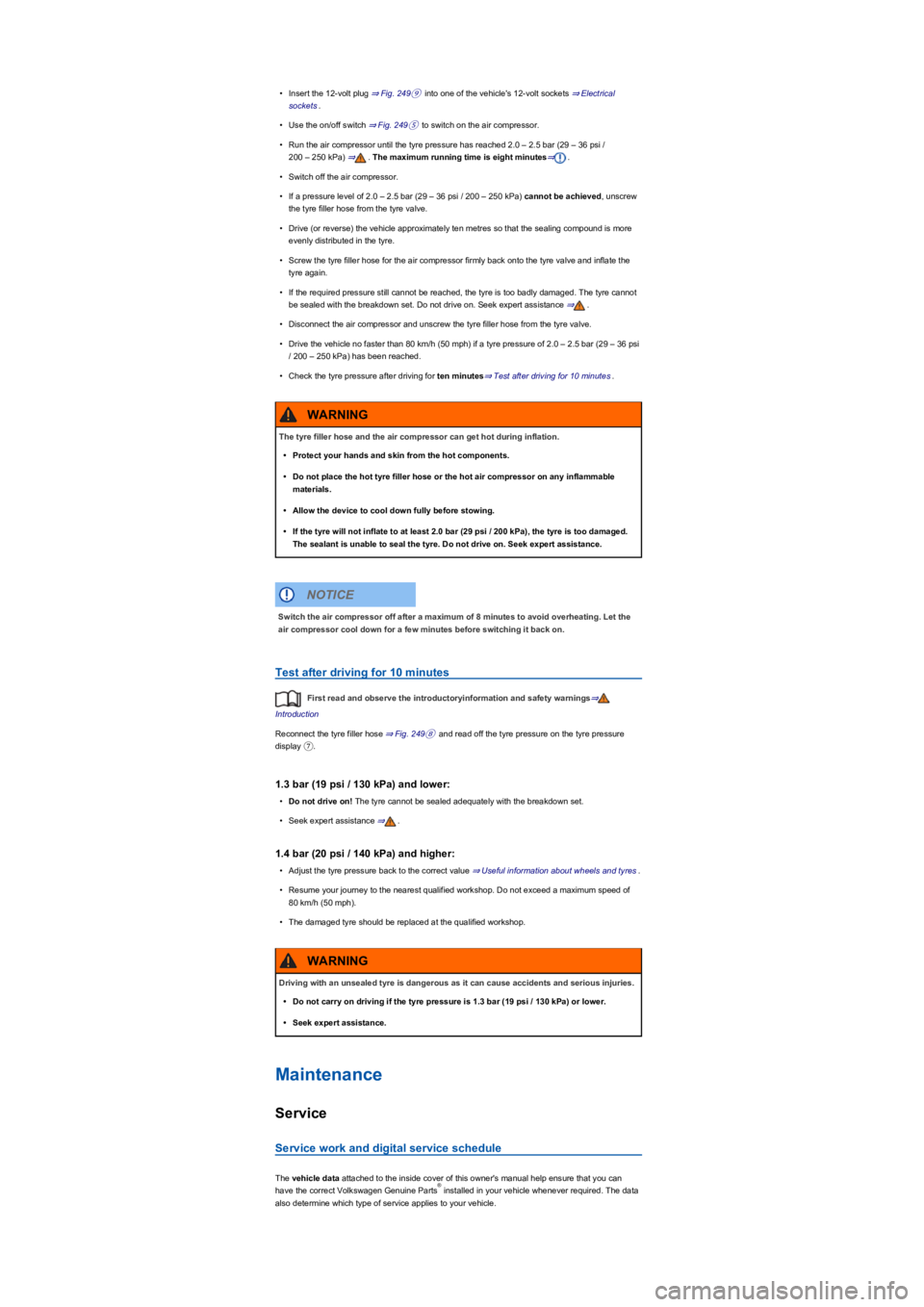
•Insert the 12-volt plug ⇒ Fig. 249⑨ into one of the vehicle's 12-volt sockets ⇒ Electrical
sockets.
•Use the on/off switch ⇒ Fig. 249⑤ to switch on the air compressor.
•Run the air compressor until the tyre pressure has reached 2.0 – 2.5 bar (29 – 36 psi /
200 – 250 kPa) ⇒. The maximum running time is eight minutes⇒.
•Switch off the air compressor.
•If a pressure level of 2.0 – 2.5 bar (29 – 36 psi / 200 – 250 kPa) cannot be achieved, unscrew
the tyre filler hose from the tyre valve.
•Drive (or reverse) the vehicle approximately ten metres so that the sealing compound is more
evenly distributed in the tyre.
•Screw the tyre filler hose for the air compressor firmly back onto the tyre valve and inflate the
tyre again.
•If the required pressure still cannot be reached, the tyre is too badly damaged. The tyre cannot
be sealed with the breakdown set. Do not drive on. Seek expert assistance ⇒.
•Disconnect the air compressor and unscrew the tyre filler hose from the tyre valve.
•Drive the vehicle no faster than 80 km/h (50 mph) if a tyre pressure of 2.0 – 2.5 bar (29 – 36 psi
/ 200 – 250 kPa) has been reached.
•Check the tyre pressure after driving for ten minutes⇒ Test after driving for 10 minutes.
Test after driving for 10 minutes
First read and observe the introductoryinformation and safety warnings⇒
Introduction
Reconnect the tyre filler hose ⇒ Fig. 249⑧ and read off the tyre pressure on the tyre pressure
display ⑦.
1.3 bar (19 psi / 130 kPa) and lower:
•Do not drive on! The tyre cannot be sealed adequately with the breakdown set.
•Seek expert assistance ⇒.
1.4 bar (20 psi / 140 kPa) and higher:
•Adjust the tyre pressure back to the correct value ⇒ Useful information about wheels and tyres.
•Resume your journey to the nearest qualified workshop. Do not exceed a maximum speed of
80 km/h (50 mph).
•The damaged tyre should be replaced at the qualified workshop.
Maintenance
Service
Service work and digital service schedule
The vehicle data attached to the inside cover of this owner's manual help ensure that you can
have the correct Volkswagen Genuine Parts installed in your vehicle whenever required. The data
also determine which type of service applies to your vehicle.
The tyre filler hose and the air compressor can get hot during inflation.
•Protect your hands and skin from the hot components.
•Do not place the hot tyre filler hose or the hot air compressor on any inflammable
materials.
•Allow the device to cool down fully before stowing.
•If the tyre will not inflate to at least 2.0 bar (29 psi / 200 kPa), the tyre is too damaged.
The sealant is unable to seal the tyre. Do not drive on. Seek expert assistance.
WARNING
Switch the air compressor off after a maximum of 8 minutes to avoid overheating. Let the
air compressor cool down for a few minutes before switching it back on.
NOTICE
Driving with an unsealed tyre is dangerous as it can cause accidents and serious injuries.
•Do not carry on driving if the tyre pressure is 1.3 bar (19 psi / 130 kPa) or lower.
•Seek expert assistance.
WARNING
®